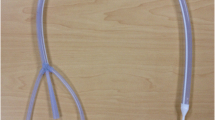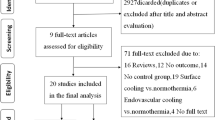Abstract
Objective
To test the convenience of a new cooling technique with intravenous heat exchange catheters.
Design
Retrospective chart review.
Setting
University hospital neurointensive care unit.
Patients
Twenty patients with severe subarachnoid hemorrhage Hunt and Hess Grade 3–5 treated with mild hypothermia.
Interventions
Cooling to reach target body core temperature (33 °C–34 °C) was induced as quickly as possible in all patients. In the first ten patients (group one) moderate hypothermia was induced and maintained using cooling blankets. In group two, an 8.5F heat exchange catheter was placed central venous and temperature-adjusted normal saline circulated in a closed-loop system entailing two balloons.
Measurements and results
A total of 2,007 values of body core temperature (BCT) were registered every hour. Foley temperature catheters were used for monitoring BCT in the bladder. The time to reach the target BCT and the stability of temperature during hypothermia were compared between the two groups. No specific complications associated with the new cooling device were observed. Time to reach the target temperature in group two was significantly shorter than in group one (190±110 and 370±220 min) (P=0.023). In group one significantly more temperature values were out of the target range (127 of 792 values; 16.0%) than in group two (62 of 1,215 values; 5.1%) (P<0.0001).
Conclusions
The new endovascular cooling technique seems to be superior for rapid induction of hypothermia and maintaining a more stable temperature than the cooling techniques using blankets and ice bags.

Similar content being viewed by others

References
Busto R, Dietrich WD, Globus MY, Ginsberg MD (1989) Postischemic moderate hypothermia inhibits CA 1 hippocampal ischemic neuronal injury. Neurosci Lett 101:299–304
Maher J, Hachinski V (1993) Hypothermia as a potential treatment for cerebral ischemia. Cerebrovasc Brain Metab Rev 5:277–300
Piepgras A, Elste V, Frietsch T, Schmiedek P, Reith W, Schilling L (2001) Effect of moderate hypothermia on experimental severe subarachnoid hemorrhage, as evaluated by apparent diffusion coefficient changes. Neurosurgery 48:1128–1135
Shiozaki T, Sugimoto H, Taneda M, Yoshida H, Iwai A, Yoshioka T, Sugimoto T (1993) Effect of mild hypothermia on uncontrollable intracranial hypertension after severe head injury. J Neurosurg 79:363–368
Metz C, Holzschuh M, Bein T, Woertgen C, Frey A, Frey I, Taeger K, Brawanski A (1996) Moderate hypothermia in patients with severe head injury: cerebral and extracerebral effects. J Neurosurg 85:533–541
Marion DW, Penrod LE, Kelsey SF, Obrist WD, Kochanek PM, Palmer AM, Wisniewski SR, DeKosky ST (1997) Treatment of traumatic brain injury with moderate hypothermia. N Engl J Med 336:540–546
Clifton GL, Miller ER, Choi SC, Levin HS, McCauley S, Smith KR Jr, Muizelaar JP, Wagner FC Jr, Marion DW, Luerssen TG, Chesnut RM, Schwartz M (2001) Lack of effect of induction of hypothermia after acute brain injury. N Engl J Med 344:556–563
Schwab S, Georgiadis D, Berrouschot J, Schellinger PD, Graffagnino C, Mayer SA (2001) Feasibility and safety of moderate hypothermia after massive hemispheric infarction. Stroke 32:2033–2035
Karibe H, Sato K, Shimizu H, Tominaga T, Koshu K, Yoshimoto T (2000) Intraoperative mild hypothermia ameliorates postoperative cerebral blood flow impairment in patients with aneurysmal subarachnoid hemorrhage. Neurosurgery 47:594–601
Bernard SA, Gray TW, Buist MD, Jones BM, Silvester W, Gutteridge G, Smith K (2002) Treatment of comatose survivors of out-of-hospital cardiac arrest with induced hypothermia. N Engl J Med 346:557–563
The Hypothermia after Cardiac Arrest Study Group (2002) Mild therapeutic hypothermia to improve the neurologic outcome after cardiac arrest. N Engl J Med 346:549–556
Georgiadis D, Schwarz S, Kollmar R, Schwab S (2001) Endovascular cooling for moderate hypothermia in patients with acute stroke. Stroke 32:2550–2553
Fandino J, Stocker R, Prokop S, Imhof HG (1999) Correlation between jugular bulb oxygen saturation and partial pressure of brain tissue oxygen during CO2 and O2 reactivity tests in severely head-injured patients. Acta Neurochir (Wien) 141:825–834
Keller E, Wietasch G, Ringleb P, Scholz M, Schwarz S, Stingele R, Schwab S, Hanley D, Hacke W (2000) Bedside monitoring of cerebral blood flow (CBF) in patients with acute hemispheric stroke. Crit Care Med 28:511–516
Committee American College of Chest Physicians/Society of Critical Care Medicine Consensus Conference Committee (1992) Definitions of sepsis and organ failure and guidelines for the use of innovative therapies in sepsis. Chest 101:1644–1655
Jennet B, Bond M (1975) Assessment of outcome after severe brain damage. A practical scale. Lancet 1:480–484
Busto R, Globus MY, Dietrich WD, Martinez E, Valdes I, Ginsberg MD (1989) Effect of mild hypothermia on ischemia-induced release of neurotransmitters and free fatty acids in rat brain. Stroke 20:904–910
Hindman BJ, Todd MM, Gelb AW, Loftus CM, Craen RA, Schubert A, Mahla ME, Torner JC (1999) Mild hypothermia as a protective therapy during intracranial aneurysm surgery: a randomized prospective pilot trial. Neurosurgery 44:23–33
Schwab S, Schwarz S, Spranger M, Keller E, Bertram M, Hacke W (1998) Moderate hypothermia in the treatment of patients with severe middle cerebral artery infarction. Stroke 29:2461–2466
Rosomoff HL (1956) Hypothermia and cerebral vascular lesions. I. Experimental interruption of the middle cerebral artery during hypothermia. J Neurosurg 13:332–343
Rosomoff HL (1957) Hypothermia and cerebral vascular lesions. II. Experimental middle cerebral artery interruption followed by induction of hypothermia. Arch Neurol Psychiatr 78:454–464
Baker CJ, Onesti ST, Solomon RA (1992) Reduction by delayed hypothermia of cerebral infarction following middle cerebral artery occlusion in the rat: a time course study. J Neurosurg 77:438–444
Carroll M, Beek O (1992) Protection against hippocampal CA1 cell loss by post-ischemic hypothermia is dependent on delay of initiation and duration. Metab Brain Dis 7:45–50
Lilly JK, Boland JP, Zekan S (1980) Urinary bladder temperature monitoring: a new index of body core temperature. Crit Care Med 8:742–744
Author information
Authors and Affiliations
Corresponding author
Rights and permissions
About this article
Cite this article
Keller, E., Imhof, HG., Gasser, S. et al. Endovascular cooling with heat exchange catheters: a new method to induce and maintain hypothermia. Intensive Care Med 29, 939–943 (2003). https://doi.org/10.1007/s00134-003-1685-3
Received:
Accepted:
Published:
Issue Date:
DOI: https://doi.org/10.1007/s00134-003-1685-3



